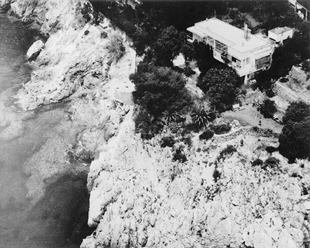E.1027
E.1027 was designed by Eileen Gray and Jean Badovici between 1926 and 1929 as a vacation residence and a showpiece of modern architecture and furnishings. Indicating the collaborative nature of the undertaking, the name of the house is a code for their intertwined initials: E for Eileen, 10 for J, the 10th letter of the alphabet, and, following this logic, 2 for B, and 7 for G. Gray was responsible for much of the design and for overseeing its construction; Badovici provided conceptual inspiration and assisted in technical matters.
E.1027 was built on an isolated stretch of the French Riviera, on the western side of Cap Martin overlooking the Bay of Monaco. Gray chose this site for the beauty of its views and set the house directly into the existing terrain of agricultural terraces. Wishing to build a house that interacted with the natural elements, she developed the design to incorporate an evolving relationship with the sun, the prevailing winds, and the sea. Inside and outside flow together. Not only does every room give out onto a balcony or terrace, but the shutters and windows are also adustable, allowing the inhabitant to harmoniously engage with the sea and the hills surrounding the villa.
The house was designed as a maison minimum — simple and efficient, with areas of built-in furniture and no wasted space. The main level of the house consists of a large open living room with a sleeping alcove and shower area for guests, a study/boudoir and bedroom, bath, and indoor and outdoor kitchens. The lower level consists of a large covered sitting area, a guest bedroom, housekeeper’s quarters, and a WC.
While E.1027 employed many of the key tenets of the Modern Movement’s chief architect, Le Corbusier, this was done in a critical manner. Gray took issue with Le Corbusier’s dictum that “the house is a machine to live in.” Rather, she described the house as a living organism, an extension of the human experience, stating that “it is not a matter of simply constructing beautiful ensembles of lines, but above all, dwellings for people.” “Formulas are nothing,” she insisted, “Life is everything. And life is simultaneously mind and heart.”
The villa’s open, flexible design allowed users to experience the dwelling as an organic whole, while simultaneously maintaining a feeling of intimacy and privacy, both of which Gray herself valued enormously. E.1027 manifests Gray’s most fundamental contribution to modern architecture.

